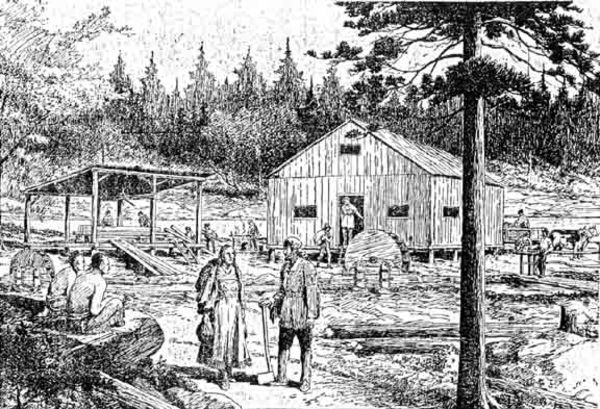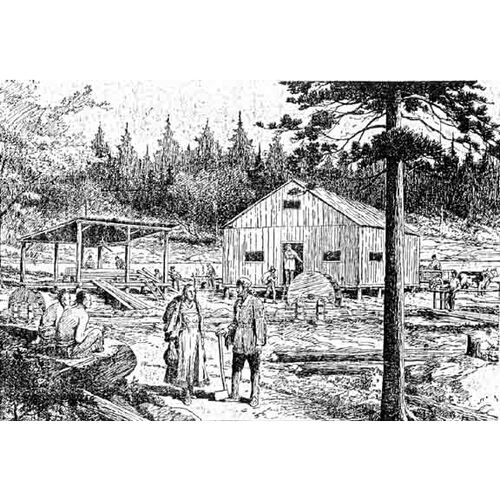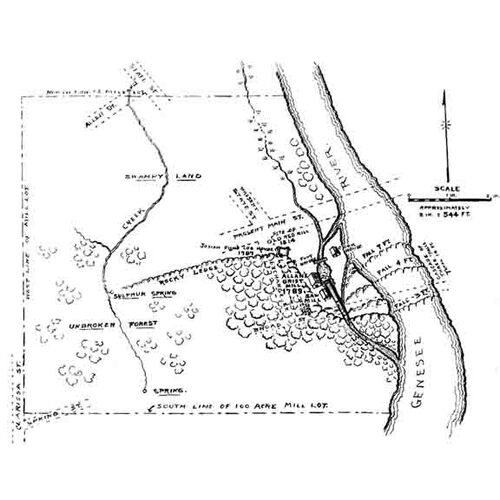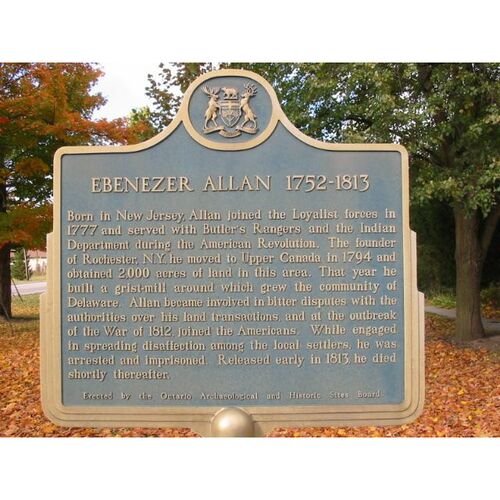
Source: Link
ALLAN (Allen, Allin), EBENEZER, businessman; b. 17 Sept. 1752 in Morristown Township (Morristown), N.J.; d. 13 April 1813 in Delaware Township, Upper Canada
Ebenezer Allan may have been living in Pennsylvania during 1777 when he decided to enlist with the loyalist unit being raised by Major John Butler*. As a result of his close ties with the Six Nations, Allan was transferred in 1781 to the Indian Department. The following year he was sent as a loyalist spy to the Genesee River area in western New York. Upon his arrival there he resided for a time with Mary Jemison, the celebrated “White Woman of the Genesee” who had been adopted in girlhood by Indians. During the winter of 1782–83 he moved to the vicinity of present-day Mount Morris, where he became more a farmer and trader than an espionage agent.
When the Indian Department began reducing its staff at the close of the Revolutionary War, Allan, who by now had attained the rank of lieutenant, was one of the officers dismissed. With this blow, it seems, he began to reconsider his allegiance to the British cause. His new attitude was probably reflected in his decision during the summer of 1783 to act as an intermediary in peace negotiations between the American government and the Six Nations. In December British authorities arrested and imprisoned Allan to prevent him from attending the council that culminated in the Treaty of Fort Stanwix in October 1784. In letters to Major Robert Mathews, Governor Haldimand’s military secretary, Allan complained bitterly about his arrest, claiming that since the end of the American revolution he had been treated in “a most cruel and inhuman manner, Robbed, Striped, Plundered, and now imprisoned in a Detestable prison like A common Criminal without even knowing my crime, or my prosecutors confronting of me.” He remained in prison for ten months, a period that was divided among jails at Fort Niagara (near Youngstown, N.Y.), Montreal, and Cataraqui (Kingston, Ont.).
After his release in late 1784 Allan returned to the Genesee valley, where he continued to farm and trade. In 1789 he completed a sawmill and a grist-mill at the Genesee Falls, thus becoming the first white settler on the site of Rochester. But an unsuccessful series of disputes with American authorities over titles to Indian land ultimately led him to abandon the Genesee region. Early in 1794 he appears to have purchased extensive holdings on the American side of the Detroit River and Lake Erie, and a farm at Petite Côte (Windsor), Upper Canada. In May Allan and a number of associates, including his brother Aaron, petitioned the Executive Council of Upper Canada for a grant of a township on the Thames River, where they proposed to establish a settlement. Although this petition was rejected, Allan, as a reduced lieutenant, was granted 2,000 acres in newly surveyed Delaware Township, some 40 miles up the Thames River from Moraviantown. The council also promised 200 acres to each settler Allan brought into the province.
In the summer of 1794 Allan, his family, and associates became the first white settlers in Delaware Township. Allan had his cattle driven in from the Genesee valley in July, built a sawmill and a grist-mill near the mouth of the present Dingman Creek within a year, and expanded his operations soon after to include the manufacture and sale of liquor. Yet, despite this auspicious beginning, life in Upper Canada soon began to go sour for Allan. By the early 1800s, as a result of unsuccessful and dubious land speculation on both sides of Lake Erie, Allan was hard pressed for capital to satisfy such creditors as John Askin and Isaac Todd, and in 1801 he sold most of his holdings in Delaware Township to Moses Brigham and Gideon Tiffany*. To make matters worse, from 1798 Allan was embroiled in quarrels with some of his neighbours, including Thomas Talbot* of Port Talbot, and with various government officials. His troubles with his neighbours stemmed largely from his failure to build a church on a clergy reserve lot, something he had agreed to do upon obtaining the land in 1794. In 1803 the Executive Council gave Allan one more year to construct the church; then all orders in council in his behalf were rescinded. Moreover, Allan was twice brought to trial in the early 1800s, once for forgery and once for larceny. Although he was acquitted on each occasion, he did not escape the clutches of the law for long: in 1804 or 1805 he was convicted of an unknown offence and imprisoned in the district jail at Turkey Point, where he remained until some time in early 1806.
Allan’s experiences during these years, as well as his long period of imprisonment in British jails at the end of the Revolutionary War, probably explain why he became an American sympathizer after the outbreak of the War of 1812. When in mid July 1812 an American scouting party advanced as far eastward as Delaware Township, Allan and two neighbours, Andrew Westbrook* and Simon Zelotes Watson, accompanied the invaders back to Sandwich (Windsor). Allan and Westbrook then returned home with copies of American brigadier-general William Hull’s proclamation to the people of Upper Canada, and actively circulated a petition requesting Hull to detach a force for the protection of those who did not wish to take up arms against the Americans. British commander Isaac Brock was faced with an alarming situation, for on the western frontier of the province desertions were numerous, many militiamen were refusing to march, and whole villages were asking for Hull’s protection. Appalled by “the state of apathy in that part of the country,” Brock instructed Daniel Springer of Delaware Township to organize a force and overawe the disaffected. Within a few days both Allan and Westbrook were made prisoners, and Allan was conveyed to Niagara (Niagara-on-the-Lake). Released early in 1813, he died in Delaware Township on 13 April.
Allan’s disregard for social conventions was well revealed in his domestic life. During his years in Delaware Township he was surrounded by “wives” and numerous children. Polygamy, however, was nothing new to him, for while residing in the Genesee valley he had been accustomed to living with several women at a time. By 1780 he had married Kyen-da-nent or Sally, a sister of the Seneca chief Captain Bull. About 1780, as well, he “married” a white woman, Lucy Chapman, and, still later, added another white woman, Mary (Milly) Gregory, to his household. His “wives,” with the exception of Sally, and all his children accompanied him to Upper Canada.
One of Allan’s critics, the author of a history of Rochester published in the 1830s, described him as a “Tory bloodhound; with a character which combines the lasciviousness of a Turk with the blood-thirstiness of a savage,” and this view was shared by several other 19th-century American writers. Yet many of Allan’s contemporaries spoke favourably of him: John Butler, for example, recommended him to Lieutenant Governor Simcoe “as a Loyalist to be depended upon,” and John Askin deemed him “as active & enterprizing a man as any in the province & perfectly sober.” In fact, Allan was neither a saint nor a villain, but simply a product of the frontier – self-reliant, capable, and hardworking, yet short-tempered, vindictive, and cruel. Because he lived close to nature and was primarily motivated by self-interest, his allegiance to higher authority was never strong.
AO, RG 22, ser.134, 4: 178–79. BL, Add.
Cite This Article
Daniel J. Brock, “ALLAN (Allen, Allin), EBENEZER,” in Dictionary of Canadian Biography, vol. 5, University of Toronto/Université Laval, 2003–, accessed December 13, 2025, https://www.biographi.ca/en/bio/allan_ebenezer_5E.html.
The citation above shows the format for footnotes and endnotes according to the Chicago manual of style (16th edition). Information to be used in other citation formats:
| Permalink: | https://www.biographi.ca/en/bio/allan_ebenezer_5E.html |
| Author of Article: | Daniel J. Brock |
| Title of Article: | ALLAN (Allen, Allin), EBENEZER |
| Publication Name: | Dictionary of Canadian Biography, vol. 5 |
| Publisher: | University of Toronto/Université Laval |
| Year of publication: | 1983 |
| Year of revision: | 1983 |
| Access Date: | December 13, 2025 |





